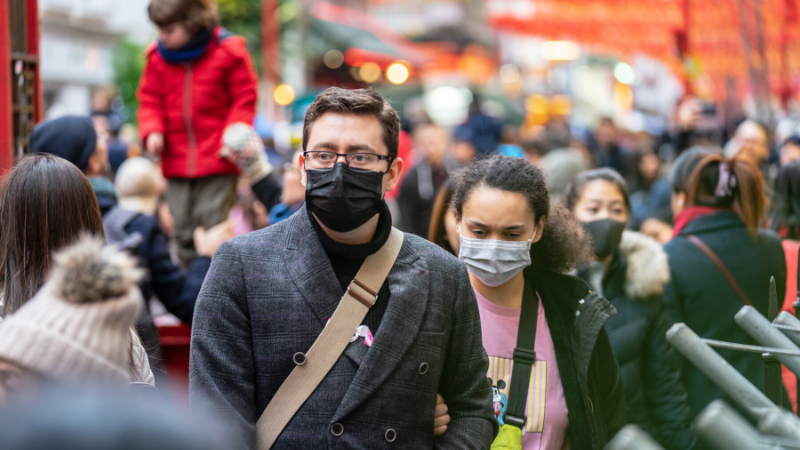

The CDC is relaxing its COVID-19 prevention guidelines. Healthy individuals living in areas where transmission do not need to wear masks indoors, a significant change from previous recommendations.
According to new CDC data, approximately 28% of people in the United States live in a county where they must wear masks indoors.
Previously, the CDC cited levels of coronavirus transmission within communities as a key metric for restrictions, recommending that people living in areas with high or substantial levels of transmission (roughly 99% of the population) wear masks indoors.
The CDC’s “Covid-19 community level” metrics are now based in a community on three pieces of data: new Covid-19 hospitalizations, hospital capacity, and new Covid-19 cases.
On the CDC’s website, you can find a list of US counties and their current Covid-19 levels. According to the revised guidelines, more than 70% of the US population lives in a community with low or medium Covid-19 levels. There I s no recommendation for indoor masking in those areas unless you are at potential “increased risk” for Covid-19, in which case the CDC recommends speaking with your health care provider about wearing a mask.
“We’re in a better place today than we were six months ago, six weeks ago, six days ago,” US Health and Human Services Secretary Xavier Becerra.
“Now it’s time to focus on severity, not just cases, of COVID. Because of all the hard work that’s been done and the many tools we’ve developed to tackle COVID, we can ease the guidance on mask use — not everyone in every place needs to wear a mask.”
The CDC recommends that people get vaccinated and boosted, as well as tested if they have symptoms, at all levels.
In “high”-level areas, the CDC also recommends wearing a mask in public indoor settings, including schools.
If you live in an area with “medium” levels, the CDC recommends speaking with your doctor about wearing a mask if you are at high risk for Covid-19.
There is no recommendation for mask use in areas with “low” Covid-19 community levels.
The CDC advises that anyone who wishes to wear a mask should do so.
“This new framework moves beyond just looking at cases and test positivity, to evaluate factors that reflect the severity of disease — including hospitalizations and hospital capacity — and helps to determine whether the level of Covid-19 and severe disease are low, medium or high in a community,” CDC Director Dr. Rochelle Walensky told reporters during a telebriefing call Friday.
“The Covid-19 community level we are releasing today will inform CDC recommendations on prevention measures, like masking, and CDC recommendations for layered prevention measures will depend on the Covid-19 level in the community,” Walensky said. “This updated approach focuses on directing our prevention efforts towards protecting people at high risk for severe illness and preventing hospitals and health care systems from being overwhelmed.”
Counties with fewer than 200 new Covid-19 cases per 100,000 people in the previous week are considered to have “low” Covid-19 community levels if they have fewer than 10 new Covid-19 hospital admissions per 100,000 or less than 10% of staffed hospital beds occupied by Covid-19 patients on average in the previous week.
Levels are considered “medium” if counties have 10 to nearly 20 new Covid-19 hospital admissions per 100,000 people, or if Covid-19 patients occupy between 10% and 14.9 percent of staffed hospital beds on average in the previous week.
Levels are considered “high” if counties have 20 or more new Covid-19 hospital admissions per 100,000 people, or if Covid-19 patients occupy at least 15% of staffed hospital beds on average in the previous week.
Counties that had 200 or more new Covid-19 cases per 100,000 people in the previous week are not considered to have “low” Covid-19 levels.
They are classified as “medium” if they have fewer than 10 new Covid-19 hospital admissions per 100,000 people or fewer than 10% of staffed hospital beds occupied by Covid-19 patients on average in the previous week.
They are considered “high” if they have 10 or more new Covid-19 hospital admissions per 100,000 people, or if Covid-19 patients occupy at least 10% of staffed hospital beds on average.
The CDC guidance update comes as daily Covid-19 cases in the United States have dropped to a tenth of what they were at their peak last month, according to Johns Hopkins University data.
The 90 percent drop occurred over the course of about six weeks, from an average of more than 802,000 cases per day on January 15 to less than 75,000 now.
When we discuss students, we always mention their qualities. Those qualities show what they are…
If you or someone you know is juggling mental health issues alongside substance abuse, understanding…
For the last couple of weeks, the Israel-Hamas conflict has taken over the news cycle.…
Our eyes are invaluable, serving as our windows to the world. The ability to see…
Undoubtedly, one of the most demanding and challenging professions is nursing. Nurses work long hours in…
Echocardiography, or echo for short, is a key diagnostic test used by cardiologists to assess…